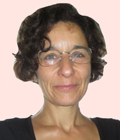
|
Lidia Quental
Remote Sensing Expert
National Laboratory on Energy and Geology
Portugal
Biography
Lídia Quental is a senior geologist at the National Laboratory for Energy and Geology (LNEG), and holds a M.Sc. in Geo-Resources and a Ph.D. in Engineering Science both at the Technical University of Lisbon (TUL). She has expertise in the domain of passive sensors, from optical, thermal and imaging spectroscopy, either spaceborne or airborne, applied to improve knowledge in thematic areas of geosciences. She participated in several EU and national R&D projects and published in scientific journals, conferences proceedings and contributed as co-author to chapters in books. She is the Portuguese delegate to the Copernicus User Forum.
Abstract
Earth Observation Contribution as a Component for Mineral Resources Systems
Co-Authors:
Daniel de Oliveira, LNEG
Augusto Filipe, LNEG
Catarina Lopes, LNEG
Carla Fortes, LNEG
Georesources support society at different levels, depending on their technological development, and thus strongly impact on the economic, societal and environmental sustainability pillars. From exploration to exploitation and mine closure, thematic spatial information is required from the scientific point of view as well as feeding several other legal frameworks both at national and EU-policy level including the Waste Directive (2006) and Raw Materials Initiative (2008). The SIORMINP is the Portuguese mineral occurrences and resources information system and contains related information such as categorization of mineral potential, past concessions, commodities reserves and resources, and exploitation activity and is available at the LNEG's geoportal (http://geoportal.lneg.pt/). Earth Observation from airborne and spaceborne platforms, given its synoptic view, and in-situ spectral data, increases the knowledge concerning georesources and mining areas characterization. The derived information from Earth Observation provides a component to be integrated or updated in minerals resources systems, such as the aerial extent of deposits and waste materials or their geochemical and mineralogical characterization depending on the sensors spatial and spectral resolution available. The detailed characterisation of mining wastes follows the Raw Materials Initiative, and are now being gathered as secondary raw materials source information in order to boost the value chain. The European Earth Observation Program, Copernicus, provides data, available from Sentinel1A, and soon forthcoming Sentinel1B and 2, which can be integrated, after dedicated image processing, as a layer component and enrich the information of minerals resources systems improving stakeholder's knowledge. In a convergence context, in the framework of the European project EuroGeoSource (http://www.eurogeosource.eu/), LNEG updated the SIORMINP dataset and published their datasets using OGC compliant Web services providing their harmonized mineral occurrences and resources data to the EUROGEOSOURCE portal. Presently, further developments related to mineral resources around Europe, concerning data, information and knowledge, are being undertaken in the framework of the MINERALS4EU project (http://www.minerals4eu.eu/).
|

